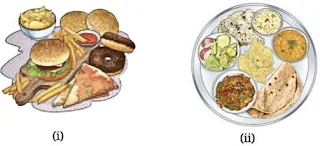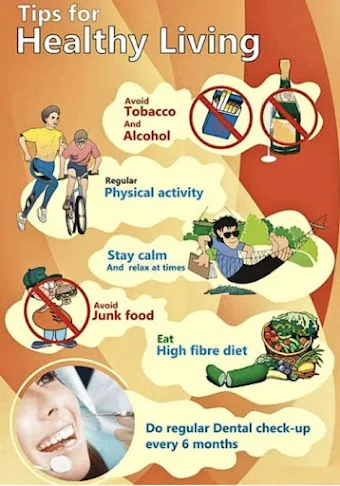Chapter 6 Adolescence: A Stage of Growth and Change Class 7 Science Curiosity NCERT Solutions
Chapter 6 Adolescence: A Stage of Growth and Change NCERT Solutions Class 7 Science
Page No. 85
Let Us Enhance Our Learning
1. Ramesh, an 11-year-old boy, developed a few pimples on his face. His mother told him that this is because of ongoing biological changes in his body.
(i) What could be the possible reasons for the development of these pimples on his face?
Answer
The pimples Ramesh is experiencing could be a result of hormonal changes that happen during adolescence. These changes can increase the production of oil (sebum) in the skin, which can clog pores and lead to pimples. This is a normal part of puberty when the body undergoes various biological and hormonal changes.
(ii) What can he do to get some relief from these pimples?
Answer
Ramesh should take care of following points:
- Maintain good hygiene: Clean the face gently with water and a mild soap or cleanser twice a day to remove excess oil and dirt.
- Avoid touching the face: Touching the face frequently can spread bacteria and cause more pimples.
- Use acne treatment products: Over-the-counter treatments like benzoyl peroxide or salicylic acid can help reduce pimples.
- Eat a balanced diet: Avoid oily and sugary foods, and focus on eating fruits, vegetables, and drinking plenty of water.
- Consult a dermatologist: If the pimples persist or worsen, Ramesh should consult a dermatologist for proper advice and treatment.
2. Which of the following food groups would be a better option for adolescents and why?

Answer
Option (ii) would be a better option for adolescents. This food group is more balanced, containing a variety of nutrients from vegetables, dal, rice, and roti. It provides essential proteins, carbohydrates, and vitamins, which are important for growth, development, and overall health during adolescence. On the other hand, option (i) contains fried foods and junk items, which are high in unhealthy fats and sugars and can lead to poor health if consumed frequently.
3. Unscramble the underlined word in the following sentences:
(i) The discharge of blood in adolescent girls which generally occurs every 28–30 days is nstmnoiaretu.
Answer
Menstruation
(ii) The hoarseness in the voice of adolescent boys is due to enlarged iceov xob.
Answer
Voice box
(iii) Secondary sexual characteristics are natural signs that the body is preparing for adulthood and mark the onset of urtypeb.
Answer
Puberty
(iv) We should say NO to lahoclo and srugd as they are addictive.
Answer
Alcohol and drugs
4. Shalu told her friend, “Adolescence brings only physical changes, like growing taller or developing body hair.” Is she correct? What would you change in this description of adolescence?
Answer
Shalu's statement is not entirely correct. Adolescence involves both physical and emotional changes.
- While physical changes like growing taller, developing body hair, and voice changes are obvious, there are also significant emotional and psychological changes during this period.
- Adolescents experience mood swings, increased sensitivity, and a growing interest in friendships, relationships, and identity exploration.
- Additionally, biological changes occur, such as the development of the reproductive system, which is a key part of adolescence.
- Thus, adolescence is a time of growth and transformation, both physically and emotionally, and should not be limited to just physical changes.
5. During a discussion in the class, some of the students raised the following points. What questions would you ask them to check the correctness of these points?
(i) Adolescents do not need to worry about behavioural changes.
Answer
Follow up questions should be:
- Why do you think behavioural changes do not matter during adolescence?
- How can understanding behavioural changes help adolescents make better decisions?
- Can you think of any examples where behavioural changes might affect the life of an adolescent?
(ii) If someone tries a harmful substance once, they can stop anytime they want.
Answer
Follow up questions should be:
- How does peer pressure influence the decision to try harmful substances?
- What makes harmful substances addictive?
- Are there any health consequences of using harmful substances even once?
- What are the risks of trying harmful substances, and how can adolescents avoid them?
6. Adolescents sometimes experience mood swings. On some days, they feel very energetic and happy, while on other days, they may feel low. What other behavioural changes are associated with this age?
Answer
During adolescence, individuals undergo significant physical, emotional, and social changes, which can lead to mood swings and other behavioural changes. Some of these changes include:
- Increased Independence: Adolescents begin seeking more independence from their parents and may make their own decisions about their activities, friends, and interests.
- Changes in Relationships: There is a growing interest in friendships. Adolescents may become more focused on peer relationships and sometimes experience conflicts with parents or family members.
- Increased Sensitivity: Teenagers often experience heightened emotions, such as feeling easily hurt or more intense reactions to situations. This can contribute to mood swings and an overall sense of emotional instability.
- Exploration of Identity: Adolescents are at a stage of self-discovery, trying to figure out who they are and where they fit in the world. This can lead to confusion, self-doubt, or changes in how they see themselves.
- Risk-Taking Behavior: Adolescents may become more willing to take risks, such as trying new things, engaging in adventurous activities, or experimenting with different social behaviors. This can sometimes lead to impulsive actions or rebellious behavior.
- Changing Interests and Hobbies: Teenagers may suddenly develop new interests or abandon old ones, reflecting their changing personality and social environment.
7. While using a toilet, Mohini noticed that used sanitary pads were scattered near the bin. She got upset and shared her feelings with her friends. They discussed the importance of menstrual hygiene and healthy sanitary habits. What menstrual hygiene and sanitary habits would you suggest to your friends?
Answer
It is essential to maintain cleanliness and hygiene during menstruation. I would suggest the following menstrual hygiene habits:
- Always use clean and sanitary pads or alternatives like menstrual cups or cloth pads.
- Change pads regularly (every 4-6 hours) to prevent infections.
- Dispose of used pads properly by wrapping them in newspaper or a plastic bag and placing them in a dustbin.
- Wash hands before and after changing pads.
- For girls, maintaining hygiene during menstruation helps prevent discomfort, infections, and other health issues.
 |
| Tips to maintain menstrual Hygiene |
8. Mary and Manoj were classmates and good friends. On turning 11, Mary developed a little bulge on the front of her neck. She visited the doctor who gave her medication and asked to take an iodine-rich diet. Similarly, a bump was developed on the front of Manoj’s neck when he turned 12. However, the doctor told him that it was a part of growing up. According to you, what could be the possible reason for advising Mary and Manoj differently?
Answer
Mary

Mary's doctor advised her to take iodine-rich food because the bulge on her neck might be due to iodine deficiency. This happens because iodine is crucial for making thyroid hormones. When there's not enough iodine, the thyroid gland swells, causing a condition known as goiter. Goiter is more common in areas with low iodine levels in the soil. It can be managed by eating iodine-rich food or taking iodine supplements.
Manoj
Manoj's bump is more likely to be the result of the natural development of the Adam's apple, a part of the larynx or voice box that grows during puberty. As boys grow older, their larynx enlarges, and this causes the Adam's apple to become more visible. This is a normal part of puberty and is not related to any deficiency or illness.
Conclusion:
- Mary's condition is due to iodine deficiency, and her doctor recommended iodine-rich foods to help manage the goiter.
- Manoj's condition is a normal part of growing up, where the Adam's apple becomes prominent during puberty.
9. During adolescence, the boys and girls undergo certain physical changes, a few of which are given below.
(i) Change in voice
(ii) Development of breasts
(iii) Growth of moustache
(iv) Growth of facial hair
(v) Pimples on the face
(vi) Growth of hair in the pubic region
(vii) Growth of hair in armpits
Categorise these changes in the table given below:

Answer
|
Observed only in boys |
Observed only in girls |
Common in boys and girls |
|
Growth of moustache |
Development of breasts |
Pimples on the face |
|
Growth of facial hair |
Growth of hair in the pubic region |
|
|
Growth of hair in armpits |
||
|
Change in voice |
10. Prepare a poster mentioning the tips for adolescents to live a healthy lifestyle.
Answer
 |
| Tips for Healthy Hygiene |

